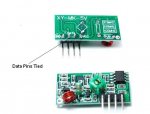Hi folks,
My house alarm and many lights on my house work remotely on 433Mhz RF.
What would be the best way to control them using picaxe?
I would need a way to read each frequency on the remotes, all buttons on alarm and lights, and a way to reproduce them on will.
If is this something that can be done? what would I need?
I have some RF communication modules for arduino and pickaxes (i think), got them on ebay: http://www.ebay.com/itm/New-RF-Wireless-Transmitter-and-Receiver-Link-Kit-Module-433Mhz-for-Arduino-DIY-/251191004511?pt=LH_DefaultDomain_0&hash=item3a7c268d5f

Is this what i need?
I have some 08M2 and some 18M2+.
Now how do i read the codes on my remotes, and after how do I reproduce them?
thanks.
My house alarm and many lights on my house work remotely on 433Mhz RF.
What would be the best way to control them using picaxe?
I would need a way to read each frequency on the remotes, all buttons on alarm and lights, and a way to reproduce them on will.
If is this something that can be done? what would I need?
I have some RF communication modules for arduino and pickaxes (i think), got them on ebay: http://www.ebay.com/itm/New-RF-Wireless-Transmitter-and-Receiver-Link-Kit-Module-433Mhz-for-Arduino-DIY-/251191004511?pt=LH_DefaultDomain_0&hash=item3a7c268d5f
Is this what i need?
I have some 08M2 and some 18M2+.
Now how do i read the codes on my remotes, and after how do I reproduce them?
thanks.




